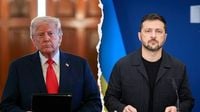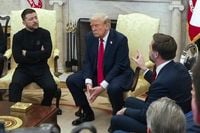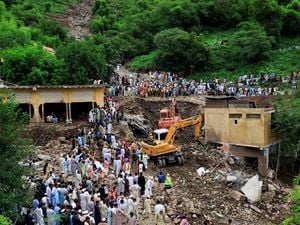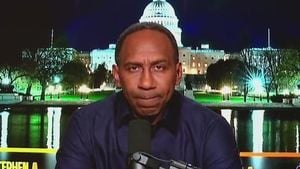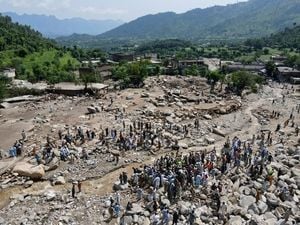As the war in Ukraine rages on, the world’s attention has turned to Washington, D.C., where Ukrainian President Volodymyr Zelenskyy arrived on August 17, 2025, for a high-stakes meeting with U.S. President Donald Trump and a delegation of top European leaders. The gathering, held at the White House on August 18, comes on the heels of Trump’s recent summit with Russian President Vladimir Putin in Alaska—a meeting that, despite lasting three hours, ended without a ceasefire agreement. The stakes could hardly be higher, with new Russian attacks devastating Ukrainian cities and the future of European security hanging in the balance.
The diplomatic flurry began after Trump’s Alaska talks with Putin on August 15, which the U.S. president described as “productive,” though no breakthrough on a ceasefire was reached. According to reporting from Fox News and The Washington Post, Putin reportedly offered to freeze most front lines in Ukraine if Kyiv withdrew from the eastern regions of Donetsk and Luhansk. Zelenskyy, however, rejected this proposal outright, arguing it would deprive Ukraine of critical defensive positions and enable Moscow to launch further offensives.
“Ukrainians will not give their land to the occupier,” Zelenskyy stated, emphasizing his nation’s refusal to concede territory in exchange for peace. This firm stance was echoed by European leaders, who met ahead of the White House summit and underscored that any territorial negotiations must include Kyiv directly. German Chancellor Friedrich Merz, French President Emmanuel Macron, and British Prime Minister Keir Starmer were among those reinforcing Ukraine’s right to determine its own fate.
Meanwhile, the war’s brutal reality was on full display. Just hours before the Washington meeting, Russian drone attacks struck the Ukrainian city of Kharkiv, killing at least four people—including a toddler—and injuring more than a dozen others. Kharkiv Governor Oleh Synehubov reported that four drones hit a five-story apartment block, causing fires and widespread destruction. Similar attacks targeted Odessa and Russian-occupied Donetsk, drawing international condemnation. Ukrainian Foreign Minister Andrii Sybiha called Russia “a murderous war machine that Ukraine is holding back,” urging “transatlantic unity and pressure” to halt the violence.
Against this bloody backdrop, Trump’s public statements added fuel to the diplomatic fire. On August 17, he posted on Truth Social, “President Zelenskyy of Ukraine can end the war with Russia almost immediately, if he wants to, or he can continue to fight.” Trump insisted that Ukraine’s hopes of reclaiming Crimea—annexed by Russia in 2014—and joining NATO were “off the table,” mirroring Kremlin demands. “No getting back Obama given Crimea (12 years ago, without a shot being fired!), and NO GOING INTO NATO BY UKRAINE. Some things never change!!!” Trump wrote, a message that drew sharp criticism from Ukrainian officials and many in the West.
Trump’s rhetoric, while encouraging a swift resolution, has placed the burden squarely on Zelenskyy to accept terms that many in Ukraine and Europe consider unpalatable. The Institute for the Study of War (ISW), a Washington-based think tank, reported on August 12 that Putin’s proposal “demands that Ukraine concede this critical defensive position, which Russian forces currently have no means of rapidly enveloping or penetrating, apparently in exchange for nothing.” The ISW further warned that Russia’s demands to address the “root causes” of the war—including halting NATO’s eastward expansion—would jeopardize the alliance’s integrity and the security of both Europe and the U.S.
European leaders have responded by calling for increased pressure on Moscow and stronger security guarantees for Ukraine. German Foreign Minister Johann Wadephul declared, “For Ukraine to be able to defend itself even after a peace agreement, firm security guarantees are central.” U.S. envoy Steve Witkoff suggested that Washington could offer Ukraine “Article 5-like protection,” referencing NATO’s mutual defense clause, though such guarantees would not come from NATO itself but rather from the U.S. and its European partners. Ukraine, for its part, is seeking treaty-level obligations that would require Senate approval, aiming to ensure that any agreement is both enforceable and enduring.
Zelenskyy, in a series of posts on X (formerly Twitter), expressed gratitude for Western support but insisted that only “enforceable guarantees” could prevent future Russian aggression. He referenced the failed security assurances of the 1994 Budapest Memorandum, which did not stop Moscow from seizing Crimea and parts of Donbas in 2014. “We all share a strong desire to end this war quickly and reliably. And peace must be lasting,” Zelenskyy wrote. He highlighted recent Ukrainian military successes in Donetsk and Sumy regions, asserting, “I am confident that we will defend Ukraine, effectively guarantee security, and that our people will always be grateful to President Trump, everyone in America, and every partner and ally for their support and invaluable assistance.”
The White House meeting itself was carefully choreographed. European leaders were scheduled to arrive by noon, followed by a bilateral meeting between Trump and Zelenskyy at 1:15 p.m., and then a larger gathering with all parties at 3:00 p.m. The discussions were expected to focus on security guarantees, the status of Russian-occupied Ukrainian territory, and the possibility of a temporary ceasefire as a precursor to real peace talks. Secretary of State Marco Rubio told NBC News that “there have to be some security guarantees for Ukraine,” while also noting that “no one is pushing Ukraine to give that up,” referring to land occupied by Russia.
Yet, the path to peace remains fraught with obstacles. Trump’s approach—emphasizing land “swapping” and signaling that Ukraine must accept territorial losses—stands in stark contrast to the positions of both Kyiv and many European capitals. The U.S. president has previously accused Ukraine of starting the conflict, a claim widely debunked by international observers who point to Russia’s full-scale invasion in February 2022 as the war’s true origin. Secretary of State Anthony Blinken, speaking to the United Nations in 2024, famously stated, “If Russia stops fighting, the war ends. If Ukraine stops fighting, Ukraine ends.”
As the day’s meetings unfolded, the world watched closely. European officials stressed that their nations would need to be part of any final peace agreement, and many expressed skepticism that Moscow would honor its commitments without robust, enforceable guarantees. Trump, for his part, indicated that if talks with Zelenskyy were successful, he would facilitate further discussions with Putin in hopes of securing a permanent end to the war.
The outcome of these talks remains uncertain. What is clear, however, is that Ukraine’s future—and the security of Europe—hangs in the balance. With Russian bombs still falling and diplomatic tensions running high, the world waits to see whether Washington’s latest summit will bring the war any closer to a just and lasting peace.
